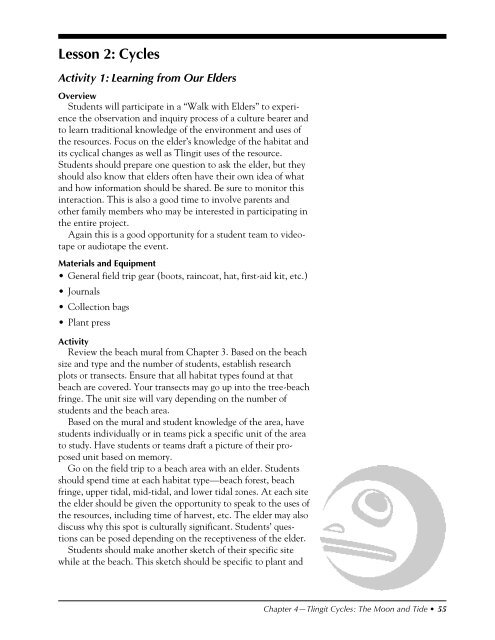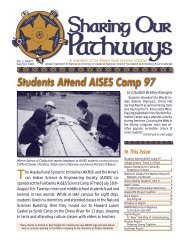Tlingit Moon & Tide - Alaska Native Knowledge Network - University ...
Tlingit Moon & Tide - Alaska Native Knowledge Network - University ...
Tlingit Moon & Tide - Alaska Native Knowledge Network - University ...
You also want an ePaper? Increase the reach of your titles
YUMPU automatically turns print PDFs into web optimized ePapers that Google loves.
Lesson 2: Cycles<br />
Activity 1: Learning from Our Elders<br />
Overview<br />
Students will participate in a “Walk with Elders” to experience<br />
the observation and inquiry process of a culture bearer and<br />
to learn traditional knowledge of the environment and uses of<br />
the resources. Focus on the elder’s knowledge of the habitat and<br />
its cyclical changes as well as <strong>Tlingit</strong> uses of the resource.<br />
Students should prepare one question to ask the elder, but they<br />
should also know that elders often have their own idea of what<br />
and how information should be shared. Be sure to monitor this<br />
interaction. This is also a good time to involve parents and<br />
other family members who may be interested in participating in<br />
the entire project.<br />
Again this is a good opportunity for a student team to videotape<br />
or audiotape the event.<br />
Materials and Equipment<br />
• General field trip gear (boots, raincoat, hat, first-aid kit, etc.)<br />
• Journals<br />
• Collection bags<br />
• Plant press<br />
Activity<br />
Review the beach mural from Chapter 3. Based on the beach<br />
size and type and the number of students, establish research<br />
plots or transects. Ensure that all habitat types found at that<br />
beach are covered. Your transects may go up into the tree-beach<br />
fringe. The unit size will vary depending on the number of<br />
students and the beach area.<br />
Based on the mural and student knowledge of the area, have<br />
students individually or in teams pick a specific unit of the area<br />
to study. Have students or teams draft a picture of their proposed<br />
unit based on memory.<br />
Go on the field trip to a beach area with an elder. Students<br />
should spend time at each habitat type—beach forest, beach<br />
fringe, upper tidal, mid-tidal, and lower tidal zones. At each site<br />
the elder should be given the opportunity to speak to the uses of<br />
the resources, including time of harvest, etc. The elder may also<br />
discuss why this spot is culturally significant. Students’ questions<br />
can be posed depending on the receptiveness of the elder.<br />
Students should make another sketch of their specific site<br />
while at the beach. This sketch should be specific to plant and<br />
Chapter 4—<strong>Tlingit</strong> Cycles: The <strong>Moon</strong> and <strong>Tide</strong> • 55



